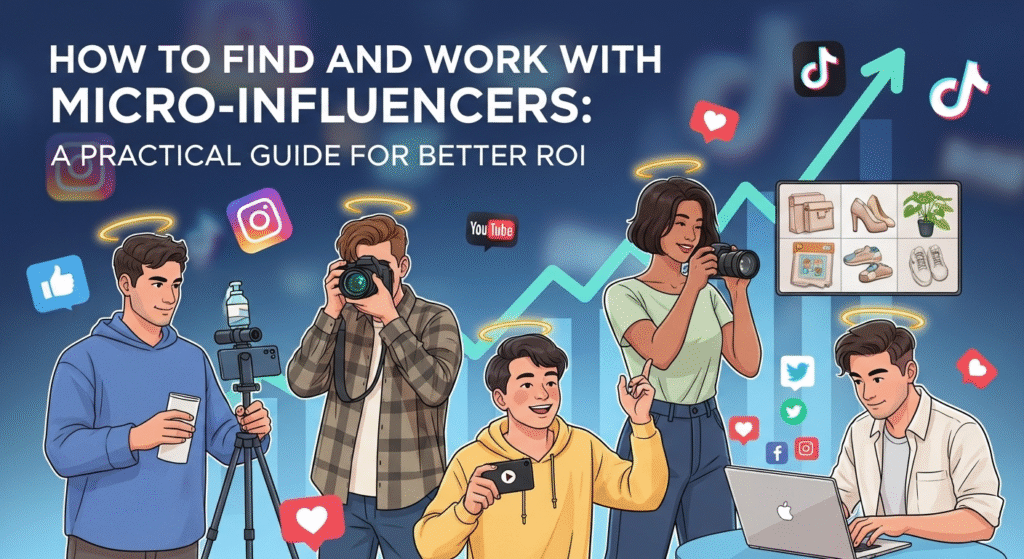Micro-influencers are delivering the best marketing results in 2025. With 10,000 to 100,000 followers, these creators offer superior engagement rates and authentic connections that mega-influencers simply can’t match. Here’s your practical guide to finding and working with them effectively.
Why Micro-Influencers Outperform Mega-Influencers
Higher Engagement: Micro-influencers achieve 3-7% engagement rates compared to 1-2% for mega-influencers.
Authentic Connections: Smaller audiences enable genuine relationships and personal interactions with followers.
Niche Expertise: They often specialize in specific topics, making their recommendations more trusted and credible.
Cost Effective: Multiple micro-influencer partnerships often cost less than one mega-influencer while providing broader reach.
Local Relevance: Many serve specific geographic areas, perfect for location-based campaigns.
Finding the Right Micro-Influencers
Define Your Criteria First:
Target audience demographics and interests
Content quality and consistency standards
Engagement rate minimums (aim for 3%+)
Brand safety and values alignment
Geographic location if relevant
Search Methods That Work:
Hashtag Research: Search relevant industry hashtags to discover creators posting about your niche. Look for consistent, quality content with good engagement.
Sample Outreach Template: “Hi [Name], I loved your recent post about [specific content]. Your audience engagement around [topic] aligns perfectly with our [brand/product]. We’d love to explore a
Social Listening Tools: Monitor brand mentions and industry conversations to find
creators already discussing relevant topics.
Platform Discovery Features: Use Instagram’s “Explore” page and TikTok’s search function to find creators in your space.
Influencer Databases: Platforms like AspirelQ, Upfluence, and Creator.co provide filtered searches based on your specific criteria.
Evaluating Potential Partners
Red Flags to Avoid:
Sudden follower spikes (indicates purchased followers)
Generic, low-quality comments
Engagement rates below 2%
Inconsistent posting schedules
Content that conflicts with your brand values
Green Flags to Look For:
Steady, organic growth patterns
Meaningful comment conversations
Professional content quality
Clear brand positioning
Previous successful brand partnerships
Reaching Out Effectively
Craft Personalized Outreach Messages:
Reference specific content you admire
Explain why they’re a good fit for your brand
Be clear about campaign expectations
Mention compensation upfront
Keep initial messages concise but warm
partnership. Are you open to discussing a collaboration? We offer [compensation type] for campaigns.”
Structuring Successful Partnerships
Campaign Brief Essentials:
Clear objectives and KPIs
Content requirements and guidelines
Timeline and deliverables
Usage rights and exclusivity terms
Compensation details
Content Guidelines That Work:
Allow creative freedom within brand parameters
Provide brand assets but don’t mandate their use
Focus on authentic integration rather than obvious advertising
Request disclosure compliance (legal requirement)
Compensation Models
Popular Payment Structures:
Flat Fee: Simple upfront payment for specific deliverables. Good for straightforward campaigns with clear scope.
Performance-Based: Payment tied to engagement rates, clicks, or conversions. Motivates creators to optimize performance.
Product Exchange: Suitable for lower-budget campaigns or product launches. Works best with creators genuinely interested in your products.
Revenue Sharing: Commission-based model for creators who drive sales. Aligns creator incentives with business outcomes.
Hybrid Models: Combination of flat fee plus performance bonuses. Provides security for creators while incentivizing results.
Managing Multiple Micro-Influencer Campaigns
Organization Systems:
Use spreadsheets or CRM tools to track outreach and responses
Create content calendars for coordinated campaigns
Establish clear communication channels
Set up tracking systems for performance monitoring
Scaling Best Practices:
Develop teniplated briefs and contracts
Create creator resource kits with brand assets
Build relationships with high-performing creators for repeat collaborations
Establish clear approval processes for content review
Measuring Campaign Success
Key Metrics to Track:
Reach and impressions
Engagement rates and quality
Click-through rates to your website
Conversion rates and sales attribution
Brand mention sentiment
Follower acquisition from campaigns
ROI Calculation: Track total campaign costs against measurable outcomes like sales, leads, or brand awareness lift to determine true return on investment.
Building Long-Term Relationships
Retention Strategies:
Pay promptly and fairly
Provide feedback and support
Offer exclusive access to new products
Include top performers in larger campaigns
Maintain regular communication between campaigns
Creator Development:
Share campaign performance data
Provide constructive feedback
Recommend creators to industry contacts
Feature their content on your brand channels
Common Mistakes to Avoid
Over-Control: Don’t micromanage creative processes. Trust creators to know their audience best.
Unrealistic Expectations: Understand that authentic content takes time and may not follow traditional advertising formats.
Poor Communication: Be responsive, clear, and professional in all interactions.
Inadequate Tracking: Set up proper attribution and tracking systems before launching campaigns. Ignoring FTC Guidelines: Ensure all sponsored content includes proper disclosure (#ad, #sponsored).
Advanced Strategies for 2025
Al-Powered Discovery: Use advanced tools to identify creators based on audience psychographics rather than just demographics.
Cross-Platform Campaigns: Work with creators across multiple platforms for integrated campaigns.
Community Building: Focus on creators who can help build brand communities rather than just drive individual campaigns.
Content Repurposing: Negotiate rights to use influencer content across your other marketing channels.
Conclusion
Micro-influencers represent the future of authentic, effective social media marketing. Their ability to build genuine connections with engaged audiences makes them invaluable partners for brands seeking real results over vanity metrics.
Success with micro-influencers requires a strategic approach: careful selection, clear communication, fair compensation, and long-term relationship building. The brands that master these elements will achieve superior ROI while building authentic connections with their target audiences.
Start small, test different approaches, and scale what works. With the right strategy and execution, micro-influencers can become your most effective marketing channel in 2025.

